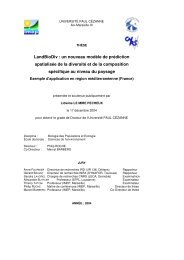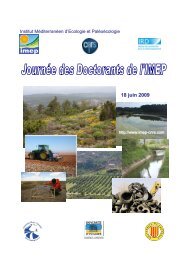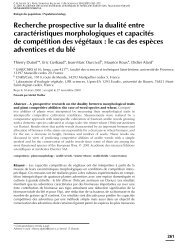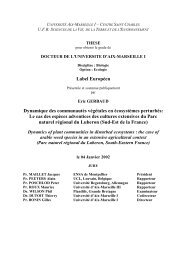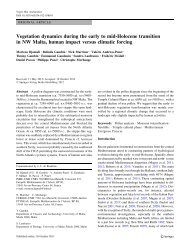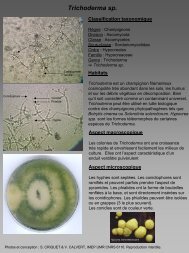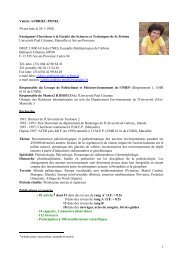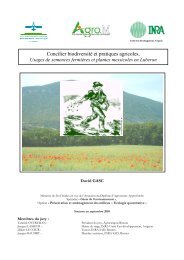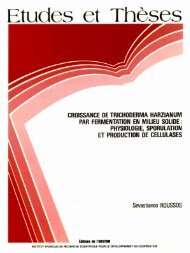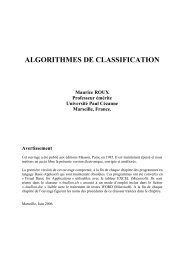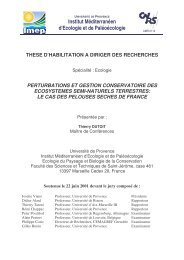UNIVERSITÉ PAUL CÉZANNE, AIX MARSEILLE III - IMEP
UNIVERSITÉ PAUL CÉZANNE, AIX MARSEILLE III - IMEP
UNIVERSITÉ PAUL CÉZANNE, AIX MARSEILLE III - IMEP
You also want an ePaper? Increase the reach of your titles
YUMPU automatically turns print PDFs into web optimized ePapers that Google loves.
Résultats et discussion. Chapitre 5: Disponibilité des substrats oléicoles<br />
2.3. Determination of the OMW retention capacity by olive cake<br />
This test consisted to contact 3 kg of crude OC with 3 L of OMW under gentle<br />
periodic mixing. Every 15 min, an homogenous sample of the mixture was taken from which<br />
the solids were recovered by filtration from the liquid and weighted (Sebabi et al., 2003). The<br />
sampling was repeated until the weight of the solid phase did not change over 3 successive<br />
measurements. The moisture of the solid phase was also determined at each sampling by<br />
drying a subsample at 105°C in an oven for 24 hours. Humidity was determined in the same<br />
way for all the other experiments. Besides the estimation of the maximum amount of OMW<br />
which can be absorbed by OC, this test allowed to determine the minimal time required to<br />
reach this objective. These experiments were performed in triplicate.<br />
2.4. Drying experiments<br />
Outdoor and greenhouse drying were performed under identical conditions in order to<br />
be comparable. Saturated OC with OMW (no free liquid OMW present) were distributed<br />
uniformly in thin layer on the trays the bottoms of which were covered by plastic mesh. The<br />
solids on the trays were turned manually once every hour. The drying process was pursued<br />
until reaching the target moisture. For that, the whole solid present on each trays were<br />
weighted periodically at 1 h intervals using a digital balance and their moisture content was<br />
determined. Solar radiation and temperature inside and outside the greenhouse were<br />
determined periodically. In order to avoid the interference of rain on the outdoor drying<br />
process, it was planned to cover the shelves with a plastic sheet during rainfall events. Finally<br />
this was unnecessary since no rain occurred during all the experimental period (February<br />
2008).<br />
2.5. Chemical characterization of dried crude olive cake and OC-OMW mixture<br />
OC and the new product (OC-OMW mixture) both dried at 10% (w/w) humidity in the<br />
same conditions were characterized for their content in carbon, nitrogen (proteins), fats and<br />
total phenols. Carbon and nitrogen concentrations were determined by a combustion-gas<br />
chromatography technique (Flash EA 1212 Elemental Analyzer, France). The instrument was<br />
calibrated with aspartic acid standard. The amount of proteins was estimated from the<br />
nitrogen content using the general factor of 6.25 (Weinberg et al., 2008). Fats were obtained<br />
by Soxhlet extraction with hexane as solvent according to established procedures (Cordova et<br />
al., 1998). Phenol content was assessed as follows: 10 mL of 60% (v/v) ethanol-water were<br />
added to 1 g of milled solid sample. The mixture was homogenized, incubated for 1 h at 4°C<br />
132



